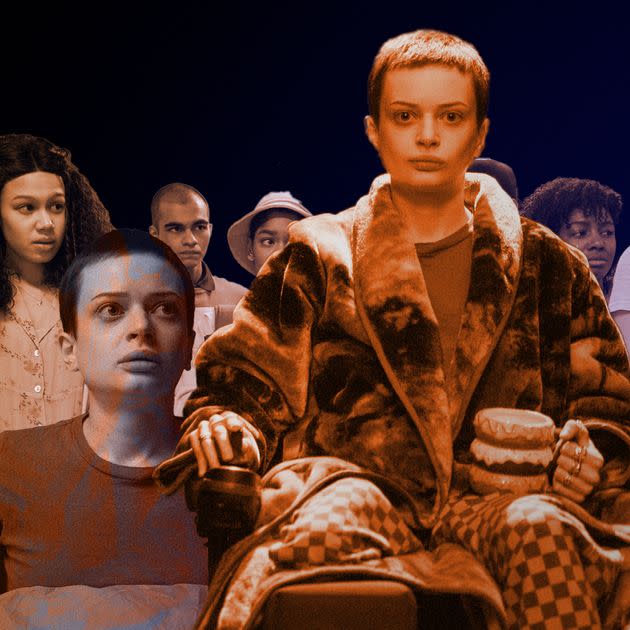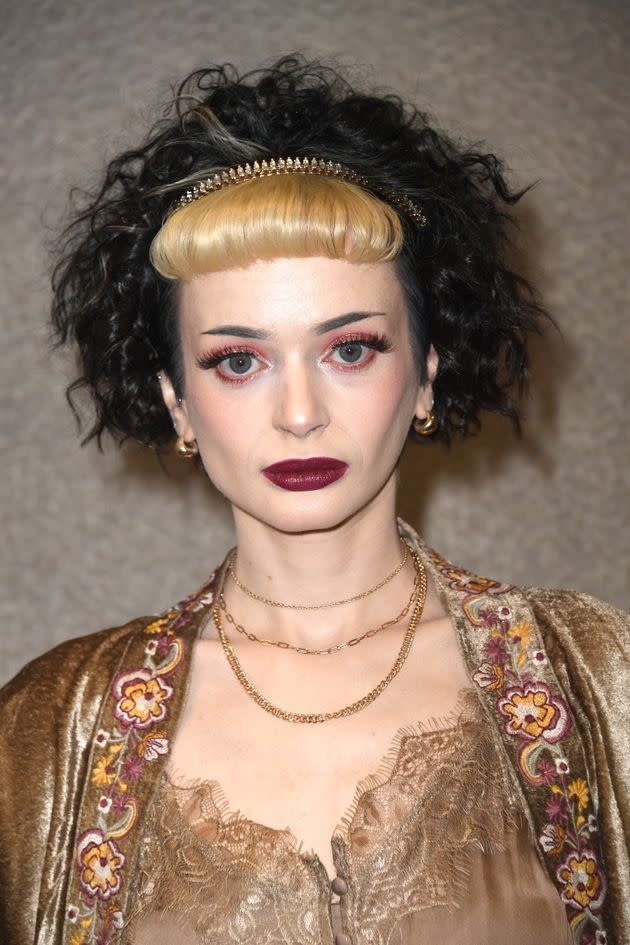What Netflix’s 'The Midnight Club' Gets Right About Disability Representation
- Oops!Something went wrong.Please try again later.

Ruth Codd in Netflix's "The Midnight Club." (Photo: Illustration: Chris McGonigal/HuffPost; Photos: Netflix)
I’ll be honest: When I first learned about Netflix’s new horror series “The Midnight Club,” I was nervous. As a wheelchair user myself, one might think I would be excited to see a character using a power wheelchair prominently displayed in the promotional images ― but I’ve learned to assume the worst when it comes to disability representation in the media.
I was intrigued to learn that the showrunners of “The Midnight Club” deliberately avoided the practice of “cripping up” (that is, casting able-bodied actors in disabled roles on stage or screen). Instead, the character of Anya is played by Ruth Codd, an Irish actor and amputee who previously made a name for herself discussing everything from disability to her work as a barber on TikTok.
Created by Mike Flanagan and Leah Fong and based on Christopher Pike’s 1994 YA novel series, “The Midnight Club” follows a group of teens with terminal diagnoses who decide to spend the final months of their lives at Brightcliffe, an unconventional hospice near Seattle. Instead of devoting their lives to fighting for expensive cures that may never come, the residents lay down their weapons and live in the moment. At Brightcliffe, mysteries (and, maybe, ghosts) lurk in the hallways, but one thing is unchanging: Every night, the young residents meet at midnight to drink wine and swap original ghost stories.
In many ways, I felt a certain kinship with the Brightcliffe teens as they lament being pitied or ostracized by their able-bodied peers at a formative stage in their lives. I became a quadriplegic after a spinal cord injury in my early 20s, and spent several months in an inpatient rehabilitation program for spinal cord injury survivors ― many of whom were my age. While Brightcliffe had more bumps in the night than my hospital, we often relied on the same gallows humor and defiant spirit to help each other through the trauma of near-death experiences and our newfound disabled identities.
For obvious reasons, I related most to Anya, who defies the predictable tropes that often hold back disabled characters from full-fledged characterization. In many productions, the camera views wheelchair users the same way able-bodied audience members often do — that is, with shock and a bit of awkward distance. It’s common for the camera to pan up the wheelchair dramatically as part of a “grand reveal.”

Codd attends the 50th anniversary of the Saturn Awards at the Marriott Burbank Convention Center on Oct. 25 in Burbank, California. (Photo: Albert L. Ortega via Getty Images)
In this series, though, Anya’s wheelchair is not the focus of her character’s establishing shot. Her need for accessibility features (from automatic door openers to ramps alongside stairways) is a built-in, matter-of-fact reality within the production design of “The Midnight Club.” Here, accessibility and mobility aids alike are neither forgotten nor used as scare tactics, but are allowed to simply “be.”
As played by Codd, Anya is at once acerbic and sensitive, angry and empathetic. In other words, she is fully human, which not many disabled characters are permitted to be. She embodies neither what disability theorists Carrie Sandahl and Philip Auslander call the “obsessive avenger” stereotype ― à la Captain Ahab in “Moby Dick” or Professor Henry Jarrod in “House of Wax,” both of whom seek revenge for their disabilities ― nor the “charity case,” who appeals pitiably to the benevolence of well-meaning able-bodied people. Instead, she’s just herself, deeply flawed and highly relatable.
In addition to Codd’s casting as Anya, “The Midnight Club” resists many of the other disability tropes associated with the horror genre, where wheelchairs often signify bad omens or harbingers of imminent death. In truth, wheelchairs are objects of freedom and even enjoyment for those who use them, but they are regularly depicted as confining and fearful. One of the show’s most memorable jump scares prominently features Anya’s wheelchair. Cornered by a mysterious entity that haunts the club members when their time to die is inching ever closer, Anya watches in terror from her seated position as her own shadow stands up. This is a clever reversal of the typical “haunted wheelchair” trope, with the walking shadow representing death and the non-walking wheelchair user embodying life.
Typically, disabled characters are given two options: death or cure. There is no option to live as they are. Yet despite the demons that plague her, Anya’s thirst for life never wanes. In several episodes, as she realizes she is dying, Anya asserts repeatedly that she wants to live.
I realized as I was watching that I had rarely seen a wheelchair user fight for their life on screen. In a culture where disability is still often stigmatized as a fate worse than death, saying you want to live while disabled is a radical assertion. When Anya is reimagined by her friends after her death in various stories, her disability remains evident. Even in her friends’ memories and ideal retellings, she is fully herself ― and still disabled.
There are many good reasons for showrunners and casting directors to cast disabled actors for disabled roles. From a creative standpoint, perhaps the most persuasive reason is that it simply makes shows better. Able-bodied actors who are feigning disability often use mobility aids unrealistically. Much worse, many move across the stage or screen the sheepishly, as if apologizing for their presence ― something that Anya, like many of us, would never do. On “The Midnight Club,” it’s refreshing to see an actor and a script that give a disabled character the space she needs to tell her story.
This article originally appeared on HuffPost and has been updated.
